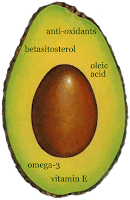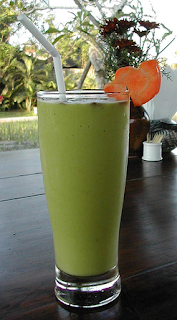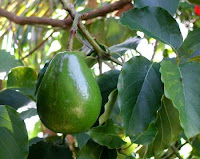Agriculture | Avocado | Avocado (Persea americana) is a tree native to Mexico and Central America, classified in the family of flowering plants and laurel widely cultivated in subtropical regions for its large edible fruit. The name "avocado" is also the fruit of the tree which is characterized by. Oval or pear-shaped, with a rough skin or leather, and a large seed, and it is sometimes known as the avocado pear or alligator pear.
Rich in an assortment of vitamins, high in monounsaturated fat and potassium, and containing a unique fatty alcohol, avocadene, avocado fruits provide curative effects for a number of human ailments, from diarrhea to high blood pressure. However, their leaves are harmfully and even fatally poisonous, causing a number of illnesses in animals. Interestingly, those illnesses include gastrointestinal irritation, of which the fruit is known to help cure.
 There is an important interdependency between avocados and people. The plant lacks a seed dispersal technique outside of humans. It is hypothesized that it originally co-evolved with large mammals that are now extinct, such as the giant ground sloth, with these ecological partners vital to seed dispersal. New mechanisms have not evolved, but the effectiveness of human intervention has allowed the plant to prosper. Of course, in exchange for this benefit, the avocado provides a nutritional and desirable fruit for people.
There is an important interdependency between avocados and people. The plant lacks a seed dispersal technique outside of humans. It is hypothesized that it originally co-evolved with large mammals that are now extinct, such as the giant ground sloth, with these ecological partners vital to seed dispersal. New mechanisms have not evolved, but the effectiveness of human intervention has allowed the plant to prosper. Of course, in exchange for this benefit, the avocado provides a nutritional and desirable fruit for people. Avocados are part of the laurel family, Lauraceae, which comprises a group of flowering plants included in the order Laurales. The avocado, P. americana, is the best-known member of the genus Persea, which is comprised of about 150 species of evergreen trees. Members of Persea are typically medium-size trees, 15-30 meters tall at maturity, with leaves that are simple, lanceolate to broad lanceolate, and flowers arranged in short panicles, with six small greenish-yellow perianth segments 3-6 mm long, nine stamens, and an ovary with a single embryo.
Avocados are part of the laurel family, Lauraceae, which comprises a group of flowering plants included in the order Laurales. The avocado, P. americana, is the best-known member of the genus Persea, which is comprised of about 150 species of evergreen trees. Members of Persea are typically medium-size trees, 15-30 meters tall at maturity, with leaves that are simple, lanceolate to broad lanceolate, and flowers arranged in short panicles, with six small greenish-yellow perianth segments 3-6 mm long, nine stamens, and an ovary with a single embryo. The avocado, P. americana, grows to 20 meters (65 feet), with alternately arranged, evergreen leaves, 12–25 centimeters long. The greenish yellow flowers are an inconspicuous 5–10 millimeters wide. The pear-shaped fruit is botanically a berry. It typically measures 7 to 20 centimeters in length and weighs between 100 and 1000 grams. The avocado fruit also has one large central seed, 3 to 5 centimeters in diameter. The avocado is a climateric fruit, which means that it matures on the tree but ripens off the tree.
The avocado, P. americana, grows to 20 meters (65 feet), with alternately arranged, evergreen leaves, 12–25 centimeters long. The greenish yellow flowers are an inconspicuous 5–10 millimeters wide. The pear-shaped fruit is botanically a berry. It typically measures 7 to 20 centimeters in length and weighs between 100 and 1000 grams. The avocado fruit also has one large central seed, 3 to 5 centimeters in diameter. The avocado is a climateric fruit, which means that it matures on the tree but ripens off the tree.An average avocado tree produces about 120 avocados annually. Commercial orchards produce an average of seven metric tons per hectare each year, with some orchards achieving 20 ton per hectare (Whiley 2007). Biennial bearing can be a problem, with heavy crops in one year being followed by poor yields the next. The common names "avocado pear" or "alligator pear" for the fruit are due to its shape and rough green skin.
It is speculated that the avocado fruit's poisonous pit was once dispersed through the excretion of an animal with which it co-evolved. However, since the disappearance of its propagating partner, human cultivation seems to have unobliged further seed dispersal-driven evolution.
Previously, lawyers had a stigma for a long time as a sexual stimulant and is not purchased or consumed by anyone who wants to preserve an image of caste. Growers had to sponsor a public relations campaign to discredit the dubious distinction of avocado, before they finally became popular. The lawyers were known by the Aztecs as "plant fertility."- AGRICULTURE
Avocado
Tags: avocado nutrition cholesterol, avocado calgary, avocado cholesterol facts, cholesterol avocado, avocado and cholesterol, avocado & cholesterol, cholesterol in avocado, avocado hummus, cholesterol and avocado, avocado cholesterol, avocado cholestrol, avocado mayonnaise recipe, west pak avocado, avocado catering, avocado allergy, avocado and diabetes, avocado roll calories, avocado diabetes, calories avocado roll




No comments:
Post a Comment